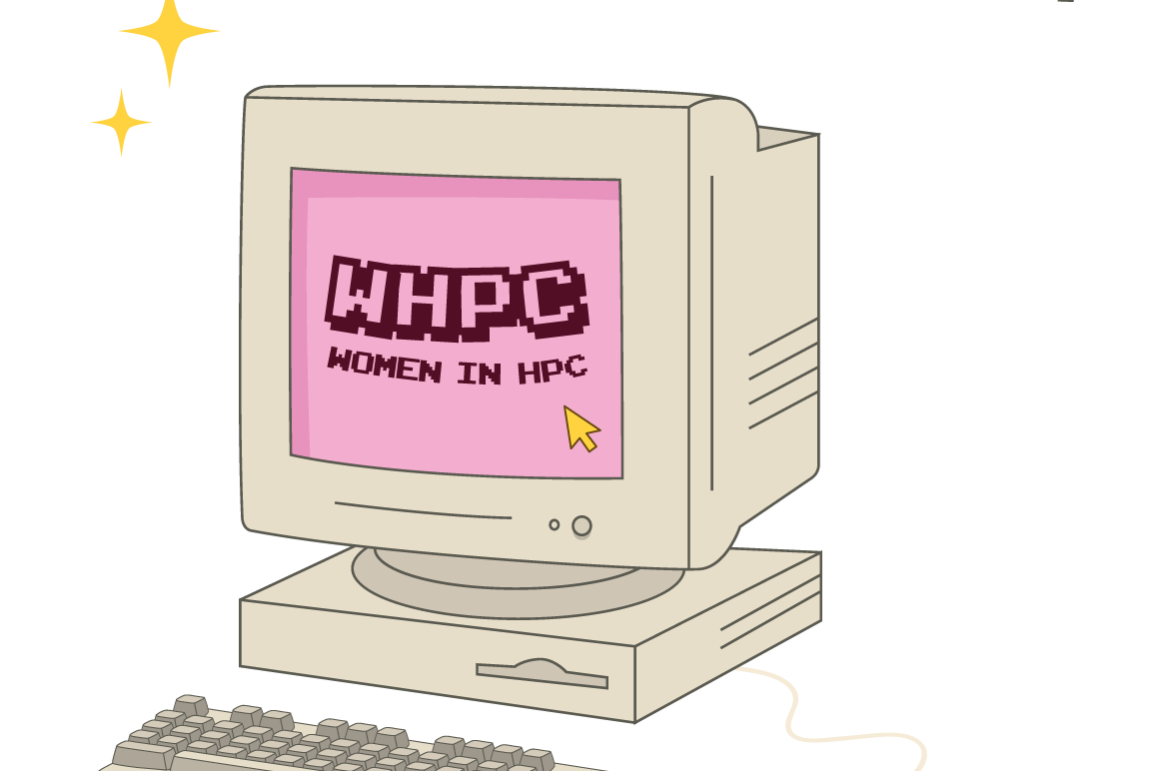Announcing the WHPC Travel Fellows for ISC 2025
Sarah Johnston and Khyati Sethia have been selected to join a growing cohort of emerging leaders and will present their research at this year’s conference.
We are thrilled to introduce the recipients of the 2025 WHPC Travel Fellowships—an opportunity made possible by the generous support of our WHPC Champions: Do It Now, AWS, and AMD, along with our WHPCxISC25g Supporters and the dedicated efforts of our Volunteers Committee.
The WHPC Travel Fellowships aim to empower rising talent in the high-performance computing community by supporting their attendance at major international conferences, giving them a platform to share their work with a global audience. This year, thanks to the continued support of our partners, the WHPC Executive and Volunteers Committees are honored to award fellowships to two outstanding individuals.
Sarah and Khyati exemplify the innovation, excellence, and leadership that WHPC is committed to advancing. We look forward to their participation at ISC 2025 in Hamburg, Germany, where they will showcase their research in the WHPC Poster Session and deliver Lightning Talks during the WHPC Tech Talks—held at the Solution Forum Theatre during the Exhibitor Gala on 10 June 2025.
Meet Our 2025 Travel Fellows
Sarah Johnston
 Sarah Johnston is a third-year astronomy PhD student in the Institute for Computational Cosmology at Durham University. She holds an MPhys in Astrophysics from University of St Andrews and is passionate about engaging with HPC and harnessing the full power of modern computing in astronomy.
Sarah Johnston is a third-year astronomy PhD student in the Institute for Computational Cosmology at Durham University. She holds an MPhys in Astrophysics from University of St Andrews and is passionate about engaging with HPC and harnessing the full power of modern computing in astronomy.
Her PhD centres around implementing a GPU offload in the SWIFT cosmology code, where she is currently developing the GPU port for gravity calculations. Having already demonstrated a proof of concept, she is currently working on optimisation and effective implementation within SWIFT’s task-based system. She also works separately on constraining mixed dark matter cosmologies using large-scale simulations.
Beyond her research Sarah is actively involved in outreach and skill development. She leads research groups for young people to get hands-on with coding and simulations and facilitates training for other researchers, helping them develop the computational expertise needed for modern astrophysics.
Sarah will be presenting “GPU Offloads for Gravity Calculations in SWIFT Cosmology Code” at the WHPC Tech Talks during Exhibitor Forum, WHPC Poster Pitch and Poster Reception. Here is a peek at her abstract:
To be compliant with modern heterogeneous HPC systems, large astronomy codes are needing to move towards GPU compatibility. This can be through total redesign or through partial offloading of key sections to GPU. SWIFT (SPH With Inter-dependent Fine-grained Tasking) is a versatile, open-source astronomy code used for a range of research areas in astronomy including galaxy formation, planetary impacts, and cosmology. SWIFT utilizes task-based parallelism, which means that the workload is divided into independent tasks that can be executed concurrently, maximizing the use of available CPU resources, and is optimised for memory-intensive large CPU-only clusters. A significant portion of SWIFT’s runtime is dedicated to gravity calculations. In gravity n-body codes, each particle (representing a celestial object) interacts with every other particle based on gravitational forces, making the calculations computationally intensive. However, the repetitive and non-interdependent nature of these n-body interactions makes them ideal candidates for GPU acceleration.
Sarah will be presenting “GPU Offloads for Gravity Calculations in SWIFT Cosmology Code” at the WHPC Tech Talks during Exhibitor Forum, WHPC Poster Pitch and Poster Reception. Here is a peek at her abstract:
In this work, we build on the existing SWIFT code by replacing specific CPU-based gravity calculation functions with new GPU kernels, minimizing disruption to the rest of the code while preserving the task-based parallelism. This creates a new hybrid C and CUDA version of the code which transfers gravity calculations to the GPU, freeing up the CPU to carry out the other tasks.
Our GPU-accelerated gravity kernels achieve high accuracy, with less than 1% deviation from CPU results below the Nyquist frequency. We also successfully produce nearly identical final particle distributions to the CPU-only implementation. Furthermore, the utilisation of GPUs allows for a redistribution of the gravity calculations meaning more interactions can be carried out using direct particle-particle summations which are more accurate, leaving only inexpensive multipole approximations to calculate on the CPU.
Khyati Sethia
 Khyati Sethia is a researcher at IT4Innovations, specializing in deep learning and high-performance computing (HPC) for scientific imaging applications, including medical imaging, scientific visualization, anomaly detection, and materials science. By leveraging GPU-rich HPC systems such as the Karolina supercomputer, she accelerates AI model training and large-scale data processing through optimized containerized workflows (Apptainer, Conda) and multi-GPU parallelization.
Khyati Sethia is a researcher at IT4Innovations, specializing in deep learning and high-performance computing (HPC) for scientific imaging applications, including medical imaging, scientific visualization, anomaly detection, and materials science. By leveraging GPU-rich HPC systems such as the Karolina supercomputer, she accelerates AI model training and large-scale data processing through optimized containerized workflows (Apptainer, Conda) and multi-GPU parallelization.
At ISC25, Khyati will present her work on scanning electron microscope (SEM) image segmentation for aluminide diffusion coatings. Her approach utilizes synthetic data generation with Blender and incorporates advanced models like U-Net and Swin UNETR, achieving both high accuracy and significant training speedups using PyTorch and Slurm. Her streamlined workflows span from DICOM preprocessing to virtual reality (VR) visualization.
With deep expertise in HPC systems and PyTorch, Khyati develops scalable machine learning solutions. As a WHPC Travel Fellow, she is committed to showcasing HPC innovation, mentoring women in STEM, promoting diversity in technology, and contributing to the HPC community through collaboration and knowledge-sharing.
Khyati will be presenting “Deep Learning Approaches for Scanning Electron Microscope Image Analysis of Slurry Coatings” at the WHPC Tech Talks during Exhibitor Forum, WHPC Poster Pitch and Poster Reception. Here is a peek at her abstract:
This study focuses on using deep learning to analyze Scanning Electron Microscope (SEM) images of aluminide diffusion coatings deposited on steel via the slurry route. The goal is to determine the thicknesses of the Fe2Al5 and FeAl coating layers, as well as the characteristics of pores and chromium precipitates. Due to challenges like imaging artefacts, noise, and overlapping features, a deep learning-based SEM image segmentation model using U-Net architecture was developed. Ground truth data were generated with the Weka segmentation plugin in ImageJ, refined manually, and augmented with synthetic data from Blender 3D. The model, trained on both synthetic and real SEM data, achieved mean dice scores of 98.7% ± 0.2 for Fe2Al5, 82.6% ± 8.1 for pores, and 81.48% ± 3.6 for precipitates. The method was applied to evaluate SEM images of coatings from three slurry compositions, revealing that slurries without rheology modifiers resulted in thicker Fe2Al5 layers. Coating thickness did not affect the relationship between outward and inward diffusion Fe2Al5 layers, with thinner coatings showing lower pore and chromium precipitate fractions. A high speed up is achieved by rendering synthetic images on HPC Karolina cluster. Also, a speed of 6.26x is achieved by performing distributed training on 8 GPUs instead of single GPU.
About the WHPC Travel Fellowships
Invitations to apply to the WHPC Travel Fellowships for ISC25 were sent to successful authors for this year’s WHPC Poster Session, scheduled from 10–12 June 2025. Applicants to our fellowship provided both a high-quality poster abstract and a personal statement. To ensure fairness, all applications were reviewed anonymously. Each fellowship recipient will receive up to £3,000 to cover travel and conference expenses, reimbursed post-conference.
WHPC Champions
Do IT Now: The Do IT Now Group delivers cutting-edge High-Performance Computing services across Europe and beyond. As market leaders, we simplify complex HPC challenges with smart, effective solutions—empowering scientists and engineers to focus on what matters most: their research.
AWS: AWS is the world’s most comprehensive cloud platform, trusted by organisations of every size. With powerful HPC capabilities and scalable infrastructure, AWS enables researchers, developers, and innovators to accelerate discovery and solve complex challenges with confidence.
AMD: AMD powers the future of high-performance computing with advanced CPUs, GPUs, and adaptive technologies. With a strong focus on innovation and energy efficiency, AMD equips researchers and engineers with the tools to tackle the most demanding scientific and technical workloads.
Special Thanks to WHPC Supporters
We extend our heartfelt appreciation to all ISC25 Supporters. Their generous contributions will enable a range of additional activities and giveaways for attendees at ISC 2025 in Hamburg, Germany.

